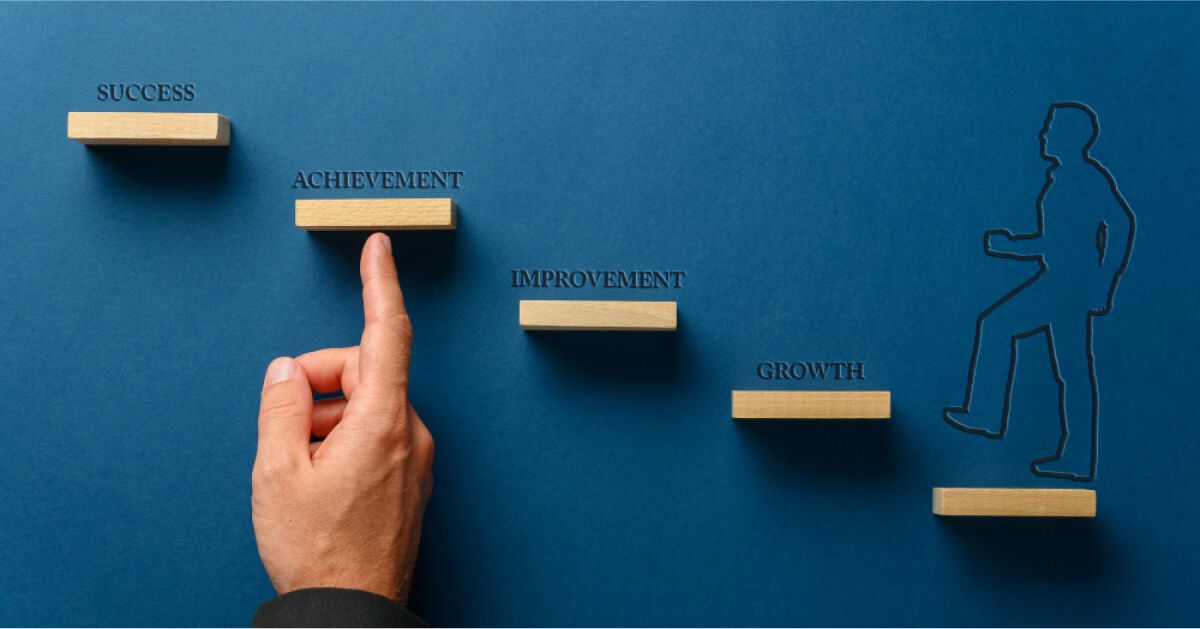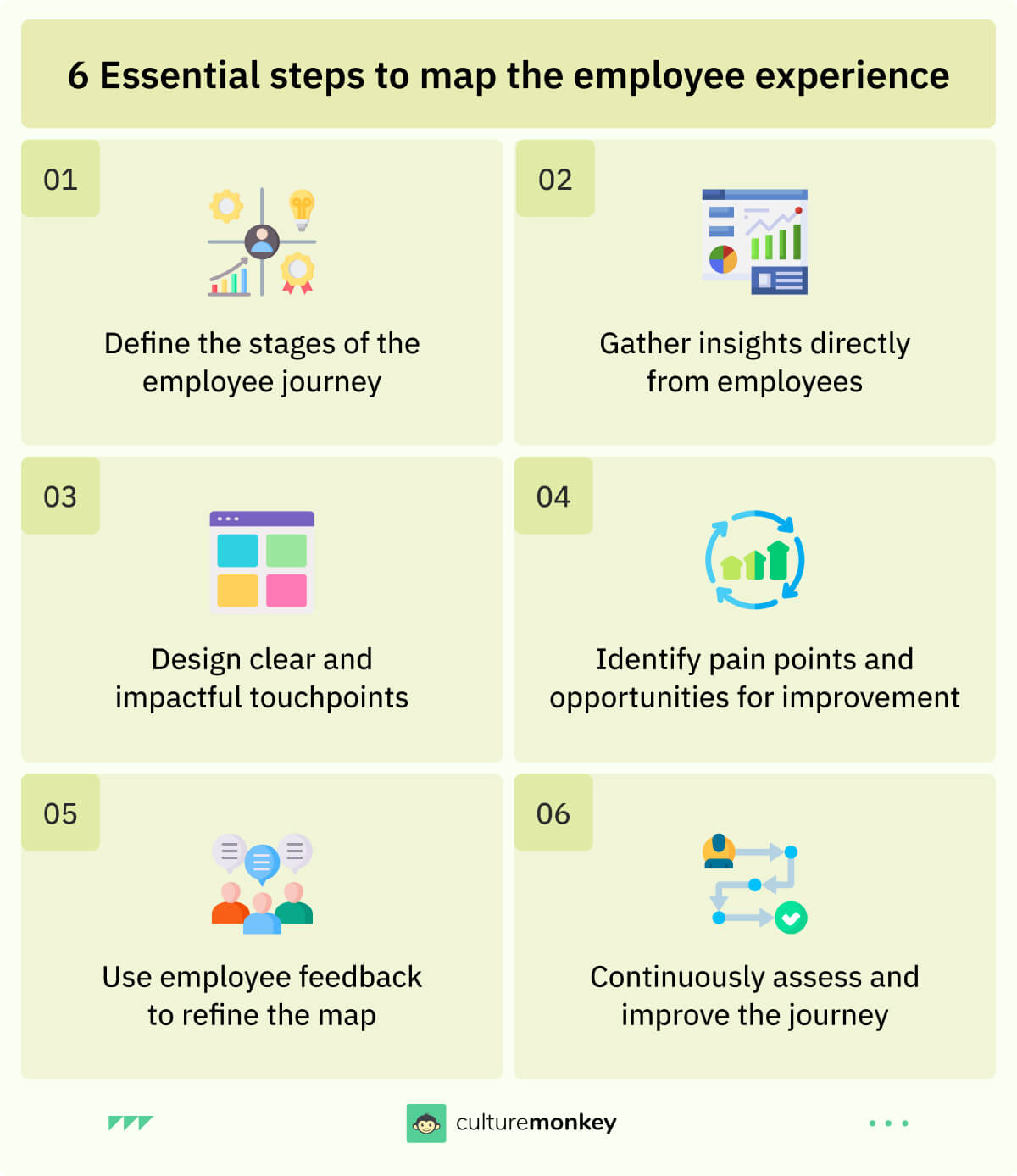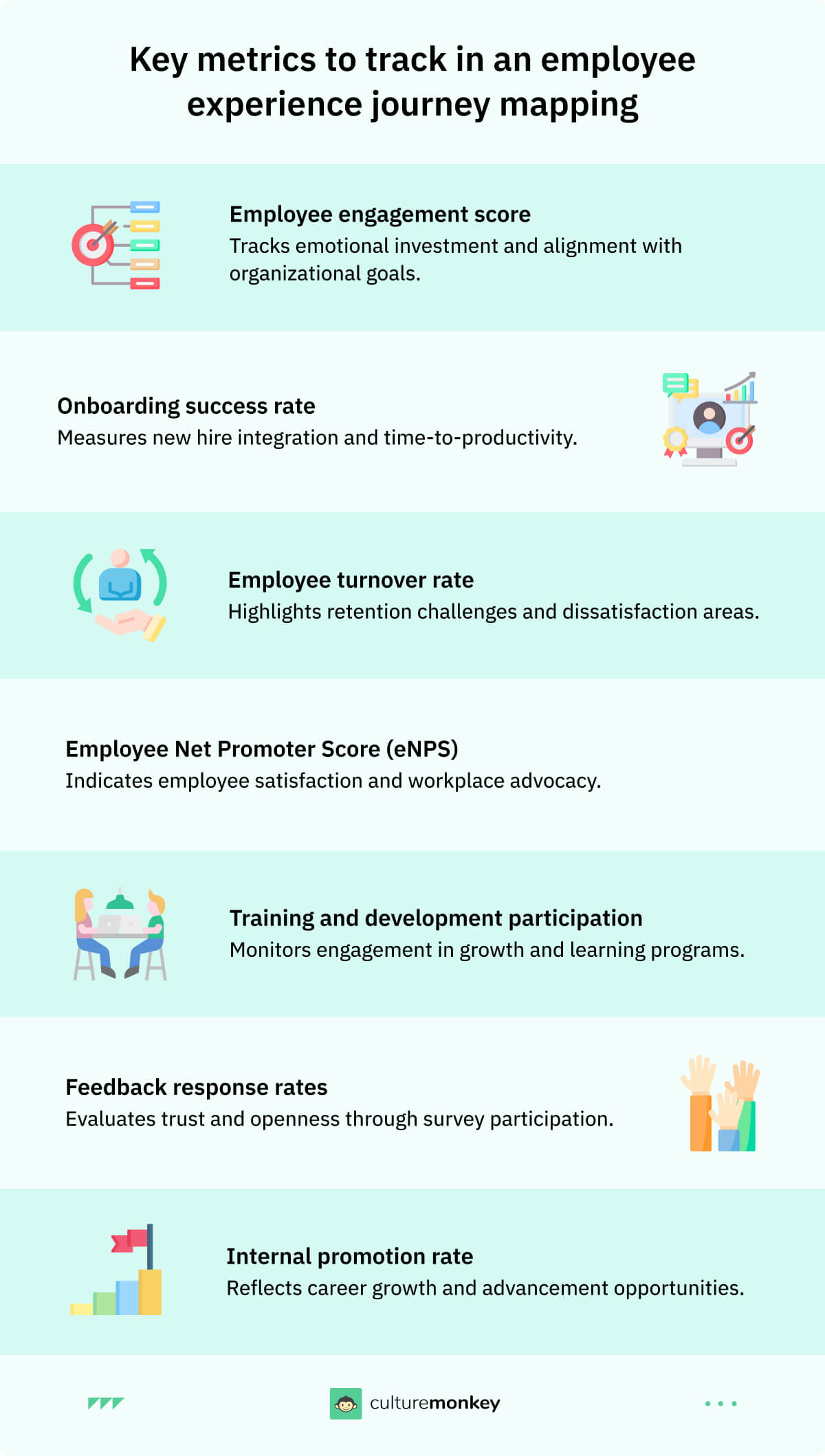How employee experience journey mapping helps create a positive workplace in 2025

Understanding the employee journey is pivotal in shaping a thriving workplace culture. From the first interaction to the final goodbye, every touchpoint defines what is employee experience and impacts employee satisfaction, engagement, and retention.
By leveraging employee journey mapping tools and analyzing employee experience touchpoints, businesses can uncover hidden challenges and bridge gaps in the employee lifecycle flowchart.
This blog explores the significance of mapping the employee journey in a company, offering actionable insights, examples, and methodologies. Whether you're crafting an employee onboarding journey or refining the exit process, this guide will help you create a seamless and impactful experience.
Blog Highlights


What is the employee journey?

Every employee goes through a unique journey in your company, from their first day of onboarding to the last day they walk out the door. But have you ever thought about what that journey looks like? And more importantly, have you thought about how you can improve it?
An employee journey can make all the difference in retaining top talent, boosting employee engagement, and improving productivity. In fact, studies have shown that companies with a strong focus on employee experience outperform their competitors by 122%. So, why aren't all companies putting more focus on the employee journey?
Employee journey mapping is a process of identifying all the touchpoints and interactions an employee has with your company, from the moment they apply for a job to their last day in the office.
A positive employee journey can lead to more engaged and productive employees. When employees feel supported and valued, they're more likely to go above and beyond in their work. And that's a win-win for everyone.
What is employee experience?

Employee experience refers to the sum of all interactions and touchpoints an employee has with their organization throughout their journey, from recruitment to exit. It encompasses their emotional, physical, and professional connection to the company, shaped by workplace culture, tools, processes, and leadership.
A positive employee experience fosters employee engagement, loyalty, and productivity, while a negative one can lead to disengagement and high turnover. By focusing on understanding employee needs and leveraging data-driven insights, organizations can design meaningful experiences. This includes aligning company values, improving communication, and enhancing key moments that matter, ensuring employees feel valued and supported at every stage.
What is employee experience journey mapping?

Employee journey mapping is the process of mapping out all the touchpoints an employee has with your company, from their first day of onboarding to their last day in the office. It's a way of understanding and improving the employee experience by mapping out their interactions with the company from the moment they first hear about the organization as a potential employer to their eventual departure.
But why should you care about employee journey maps? For one, it helps you identify pain points in the employee experience that could be driving employees away. Maybe your onboarding process is too lengthy, or your employees aren't getting enough feedback or recognition for their hard work.
It helps organizations develop a comprehensive and holistic view of the employee experience, which is critical for improving employee engagement and retention.
Employee journey mapping vs. customer journey mapping: Key differences
| Aspect | Employee Journey Mapping | Customer Journey Mapping |
|---|---|---|
| Focus | Centers on the internal experience of employees within the organization | Focuses on the external experience of customers interacting with the brand |
| Stakeholders | HR teams, managers, and leadership play a key role in shaping the employee journey | Marketing, sales, and customer service teams lead the customer journey design |
| Goals | Enhances employee engagement , retention, and productivity | Aims to increase customer satisfaction, loyalty, and conversion rates |
| Touchpoints | Includes recruitment, onboarding, training, performance reviews, and exit processes | Covers awareness, consideration, purchase, usage, and customer support stages |
| Measurement | Tracks metrics like employee satisfaction, turnover rate, and engagement levels | Measures customer satisfaction (CSAT), Net Promoter Score (NPS), and customer retention |
| Outcome | Creates a thriving workplace culture that supports employees’ growth and well-being | Builds a positive brand image, enhances customer experience, and drives revenue |
What are the benefits of employee journey mapping?
Employee journey mapping is like a treasure map, leading you to a trove of benefits. It's a strategic tool that enhances every aspect of your organization, from employee satisfaction and productivity to attracting and retaining top talent.
With a well-crafted journey map, you're on the path to creating a workplace where everyone thrives, and success is just around the corner.
- Enhanced productivity: A well-designed employee journey map helps streamline processes and remove obstacles that can hinder productivity. When employees encounter fewer roadblocks and can navigate their roles more efficiently, they become more productive. This not only benefits your employees but also positively impacts the bottom line.
- Increased retention rates: High employee turnover can be a significant drain on resources. Employee journey mapping helps create a supportive and fulfilling work environment. When employees feel well-integrated and valued, they're more likely to stay with your organization. Lower turnover rates mean cost savings in recruitment and training.
- Talent attraction: A positive employee experience journey becomes a magnet for top talent. Word-of-mouth recommendations from your content employees can be a powerful recruitment tool. A great reputation for employee experience can draw in the best and brightest in the industry.
- Clearer communication: Mapping out the journey helps identify communication gaps. Effective internal communication is key to a successful organization. By understanding where the challenges lie, you can implement strategies to improve communication, ensuring everyone is on the same page.
- Enhanced employee development: Through journey mapping, you can pinpoint opportunities for skill development and growth at every stage of the employee experience. This encourages continuous learning and personal development, which can lead to higher job satisfaction and career advancement.
- Better decision-making: Employee journey maps provide valuable data and insights. With this information, you can make informed decisions about the employee experience. Whether it's resource allocation, policy changes, or organizational improvements, you have a clear path to follow.
- Strengthened company culture: Mapping the employee journey allows you to align every stage with your company's values and culture. It's an opportunity to ensure that your culture is not just a buzzword but a real, living experience for your employees.
How to leverage employee journey mapping to create value

Understanding how to make the most of employee journey mapping is essential for modern HR professionals and business leaders. In this guide, we'll explore not only the fundamental steps in leveraging this tool but also delve into additional ways to extract maximum value from it.
Here are the key ways to leverage employee journey mapping to create value!
- Identify key touchpoints: The first step in leveraging the employee journey map is to identify the key touchpoints in the employee experience. This includes everything from recruitment to onboarding, training, performance review/management, and offboarding.
- Collect data: Once you've identified the key touchpoints, it's time to collect data on the employee experience. This can include employee feedback, employee surveys, and data on employee turnover, productivity, and employee engagement.
- Analyze the data: After collecting data, it's important to analyze it to identify pain points and areas where improvements can be made. Look for patterns and trends that can inform future decisions.
- Map out the journey: Once you clearly understand the employee experience, it's time to map out the journey. This can be done using a variety of tools, such as journey maps, employee personas, and empathy maps.
- Identify opportunities for improvement: With the employee journey mapped out, it's easier to identify areas where improvements can be made. Look for pain points and areas where the employee experience could be improved and prioritize the most critical ones.
- Implement changes: Once you've identified areas for improvement, it's time to implement changes. This can include everything from streamlining the recruitment process to improving communication and recognition programs.
- Continuously monitor and improve: Employee journey mapping is not a one-time process. It's important to continuously monitor the employee experience and make improvements as needed. This can include collecting ongoing feedback from employees, analyzing data, and making changes to improve the employee experience.



Employee experience doesn’t need to replace engagement. The two can actually work together, and in fact, they have to.
Founder
Future Of Work Leaders
- Enhance training and development : The employee journey map can highlight specific points where training and development play a crucial role. Use this information to revamp training programs, offer skill-building opportunities, and ensure that employees have the resources they need to succeed.
- Facilitate cross-department collaboration: Employee journey mapping can uncover areas where different departments need to collaborate more effectively. Foster a culture of cross-departmental teamwork to eliminate silos, improve communication, and enhance the overall employee experience.
- Customize employee experiences: Tailor the employee experience based on individual preferences and needs. Use data from the employee journey map to offer personalized career paths, flexible work arrangements, or unique benefits, providing employees with more customized experiences.
- Implement recognition and rewards: Recognize and reward employees for their contributions at key touchpoints in the employee journey. Acknowledging their achievements can boost motivation and job satisfaction, leading to a more positive overall experience.
The dos and don'ts of employee journey mapping

Employee journey mapping is a potent tool for creating a fulfilling, engaging workplace. If you follow the dos and avoid the don'ts, you're on the right path to crafting an experience that keeps your employees happy, productive, and loyal.
The Dos: Crafting a stellar employee journey map
- DO understand your employees: Before you even put pen to paper or fingers to the keyboard, take the time to truly understand your employees. Gather insights through employee engagement surveys, interviews, and feedback. Recognize their needs, desires, and pain points, and ensure these insights drive your map.
- DO define clear stages: Your map should be divided into clear, distinct stages. Start with the recruitment phase and then move through onboarding, professional development, and everyday work experiences. Clearly define the key milestones in each stage.
- DO include employee input: Employee involvement is paramount. Encourage your employees to participate in the mapping process. They can provide invaluable insights into their experiences and suggest improvements that can make the journey more engaging and fulfilling.
- DO align with company culture: Each stage of the journey should be intricately woven into your company's culture and values. It's crucial that employees feel connected to your organization's mission and vision throughout their journey.
- DO keep it dynamic: Employee journey mapping isn't a one-and-done exercise. It's a living, breathing document that should evolve with time. Regularly assess the effectiveness of each stage and make adjustments based on employee feedback and changing needs.
- DO measure outcomes: Establish key performance indicators (KPIs) to gauge the success of your employee journey map. Are employees more engaged? Is turnover decreasing? Are you attracting top talent? Use measurable outcomes to evaluate the map's effectiveness.
The don'ts: Pitfalls to avoid
- DON'T make it too complex: Simplicity is your best friend. Avoid overcomplicating the mapping process. Keep it clear and easy to understand so that everyone in your organization can follow and benefit from it.
- DON'T neglect employee feedback: If you're not actively seeking employee input, you're missing out on a goldmine of insights. Neglecting their feedback can lead to an inaccurate representation of their experiences and needs.
- DON'T stick to the status quo: An employee journey map isn't effective if it merely replicates current processes. Don't be afraid to challenge the status quo and make necessary changes for a better employee experience.
- DON'T forget continuity: The journey shouldn't end with onboarding. It's a continuous process, and all stages should seamlessly connect. Don't isolate the onboarding process from daily work experiences; instead, ensure a smooth transition.
- DON'T set it in stone: An inflexible map can become a hindrance. Don't treat your employee journey map as a final, unchangeable document. Embrace adaptability and be open to refining and adjusting the journey as your organization grows.
- DON'T ignore data: Ignoring data is one of the gravest mistakes you can make. Employee journey mapping relies on insights and measurable outcomes. Neglecting the data you gather can lead to a skewed perception of your employees' experiences.
What are the stages of the employee journey?

Here are the stages of the employee's journey, in brief:
- Application: If potential employees decide your organization is the right fit, they will typically apply for a position. This involves submitting a resume or application and potentially going through pre-employment screening and assessments.
- Interview: After submitting an application, the potential employee may be invited to interview for the position. This stage involves assessing the candidate's fit for the role and evaluating their skills and experience.
- Onboarding: If the candidate is selected for the position, they will move into the onboarding stage. This involves training and orientation to the company culture, policies, and procedures for the new employee.
- Development: Once an employee is onboarded, they will move into the development stage. This involves ongoing training and development to improve their skills and advance their career.
- Performance: The performance stage involves ongoing performance management, including setting goals, providing feedback, and evaluating performance.
- Recognition: Employees thrive on recognition, and it's important to make it a key stage in the employee journey. This includes both formal recognition programs and informal feedback and praise from managers and colleagues.
- Retention: The retention stage is where employees decide whether they want to stay with the organization or leave. During this stage, it's important to provide a positive workplace culture that values and respects employees.
- Career advancement: In the career advancement stage, employees seek opportunities for growth within the organization. This may involve taking on more responsibilities, pursuing promotions, or exploring lateral moves to develop new skills and expand their career horizons.
- Wellness and well-being: As employee well-being becomes a focal point for many organizations, a dedicated stage for wellness initiatives is crucial. This stage involves supporting employees' physical and mental health, providing resources for work-life balance, and promoting a culture of well-being.
- Separation: Finally, the separation stage involves an employee leaving the organization, whether voluntarily or involuntarily. This can involve offboarding, exit interviews, and evaluation of the employee's tenure with the company.
By understanding the stages of the employee journey, people leaders can better identify pain points and opportunities for improvement and create a positive and productive workplace culture that drives success.
Whether you're just starting or have been in the game for years, taking a strategic approach to the employee journey is key to achieving your HR goals. So, get out there and prioritise the employee journey in your organization.
Six steps for mapping the employee experience

Mapping the employee experience is your secret recipe for a workplace where employees thrive and businesses flourish. So, get ready to set sail on this transformative journey to create an exceptional workplace experience.
Step 1: Define the stages
Begin by breaking down the employee journey into stages. Start with the recruitment and onboarding phase, move on to professional development, and finally, the ongoing work experience. Each stage has its unique challenges, goals, and opportunities to shape the employee's experience.
Step 2: Employee insights
Next, gather insights directly from your employees. Conduct surveys, interviews, and feedback sessions. Ask about their aspirations, and pain points on moments that matter to them. This not only helps you understand their perspective but also makes them feel heard and valued.
Step 3: Design the experience
With a deep understanding of each stage and employee insights, it's time to design the experience. This involves creating a clear path with defined touchpoints.
For example, in the onboarding phase, ensure a warm welcome, comprehensive training, and a buddy system for support. Tailor each stage to align with your company's culture and values.
Step 4: Identify pain points and opportunities
Look closely at every stage of the employee journey to uncover areas where employees face challenges or disengagement. Use data, feedback, and observations to identify barriers such as inefficient processes, lack of communication, or limited growth opportunities.
At the same time, pinpoint moments where you can enhance the experience to create a more positive impact, such as introducing recognition programs or improving workplace resources.
Step 5: Use employee feedback to refine the map
Your employees’ feedback is the key to improving their experience. Continuously collect input through surveys, one-on-one conversations, and focus groups.
Use their suggestions and concerns to refine your journey map, addressing pain points and amplifying positive moments. By acting on feedback, you demonstrate that employee voices matter, fostering trust and engagement.
Step 6: Continuous improvement
The employee experience journey isn't set in stone. It's a dynamic process that requires continuous improvement.
Regularly assess the effectiveness of each stage, gather feedback, and make necessary adjustments. This keeps your experience fresh, relevant, and aligned with your employees' evolving needs.

How do you create an employee experience journey map?

Creating an employee experience journey map can be daunting, but it doesn't have to be. With a little bit of planning and organization, you can create an effective employee journey map that will help you improve the overall employee experience in your organization.
Here are 5 pointers on how to create an employee experience journey map:
- Define your employee personas: To create an employee journey map, you need to understand your employees. Start by defining your employee personas. These are fictional representations of your employees based on characteristics such as their job title, department, age, gender, and experience.
- Visualize the journey: Create a visual representation once you've mapped out the employee journey. This can be a flowchart, a timeline, or any other visual that helps you understand the journey.
- Set goals: Set specific, measurable goals for improving the employee experience. This could include reducing turnover, increasing employee engagement, or improving the employee onboarding process.
- Develop a plan: Once you've identified areas for improvement and set goals, develop a plan to achieve them. This may involve making changes to processes, implementing new technologies, or providing additional training to employees.
- Test: Implement your plan and test the changes you've made to the employee experience. Collect feedback from employees to ensure that the changes are having a positive impact.
Personas for employee journey mapping

Personas play a crucial role in employee journey mapping as they help create a clear picture of the employees going through different journey stages. A persona is a fictional character that represents a group of employees with similar goals, needs, and behavior patterns.
Creating personas for employee journey maps is crucial in ensuring you accurately map the employee experience.
Here are some key points to consider while creating personas for employee journey mapping:
- Research: Start by researching your employees and gathering data on their needs, behaviors, and pain points. You can collect this data from surveys, interviews, and focus groups.
- Segment your employees: Based on the data collected, segment your employees into different groups with similar needs, behaviors, and pain points.
- Give them a name: Once you have segmented your employees, give each group a name that represents them.
- Create a backstory: Create a backstory for each persona that outlines their journey, starting from their first interaction with the company to their current stage.
- Identify their goals: Identify the goals and motivations of each persona. This will help you map out the touchpoints that can help them achieve their goals.
- Understand their pain points: Identify the pain points for each persona. This will help you map out the touchpoints that can alleviate their pain points.
- Add a face: Add a visual representation to each persona to make them feel more real.
- Use personas to create empathy: Use personas to create empathy among the team and to help them understand the needs and pain points of different employees.
- Continuously update personas: The needs and behaviors of employees change over time, so it’s important to continuously update your personas to ensure they accurately represent your employees.
- Use personas to guide decision-making: Use personas to guide decision-making throughout the employee journey mapping process. This ensures that decisions are made considering the employee’s needs and pain points.
By using personas, you can create a more accurate and empathetic employee journey map that will help you improve the overall employee experience.
The employee journey from the employee’s perspective

Have you ever thought about the employee journey from the employee's perspective? As people leaders, it's important for us to put ourselves in our employees' shoes and understand how they experience their journey within the company.
From the day they first apply for a job to their last day of work, every touchpoint an employee has with the organization can impact their overall experience. This includes the hiring process, onboarding, performance evaluations, and even their exit interview.
As employees, they want to feel valued, respected and appreciated for the work they do. They want to feel like they're part of a team that is working together to achieve common goals. They want to have the resources and support they need to perform their job to the best of their abilities.
However, there are also challenges that employees face, such as navigating complex processes, dealing with office politics, and managing work-life balance. These challenges can impact employee engagement, motivation, and overall employee satisfaction with their job.
By listening to our employees' feedback and concerns, we can identify areas of improvement and make changes to enhance their journey within the organization. This benefits the employees and leads to increased productivity, retention, and a better company culture overall.
The employee journey from the employer’s perspective

From an employer’s perspective, the employee journey is a strategic roadmap to nurture, engage, and retain talent while aligning with organizational goals. It begins with attracting the right candidates, ensuring a seamless hiring process, and providing an onboarding experience that sets the tone for their journey. Employers must view each stage as an opportunity to foster a positive work environment that supports both professional and personal growth.
The onboarding stage, for example, is crucial for integrating new hires into the company culture. Employers see it as a chance to communicate expectations, establish trust, and equip employees with the tools and knowledge they need. A poorly executed onboarding process can result in early disengagement, while a thoughtful one can build long-term loyalty.
As employees progress, employers focus on continuous development and engagement. Regular feedback, recognition, and opportunities for upskilling are essential for retaining top talent. Employers view this as an investment that drives productivity and innovation, ultimately benefiting the organization’s bottom line.
Misaligned processes or a lack of communication at this stage could lead to dissatisfaction and attrition.
Finally, the separation stage offers a valuable chance to gather insights through exit interviews. Employers use this feedback to identify areas for improvement, refine their processes, and maintain a positive reputation. From recruitment to offboarding, the employee journey is a vital framework for building a thriving workplace that balances employee satisfaction with organizational success.

Make Employee Happiness Your Top Priority
Transform your workplace with employee experience journey mapping, boost productivity and create a happier team.
Employee journey mapping touchpoints

"It's not the destination, it's the journey"? Well, in the world of employee experience, that journey is known as the employee journey map. And just like any journey, it's made up of various touchpoints that shape an employee's experience.
What are these touchpoints, you may ask? They're every interaction an employee has with the company, from the moment they first hear about the job opportunity to the day they leave the company. These touchpoints can be divided into three categories:
- Pre-hire touchpoints: This includes any interaction the employee has with the company before being hired, such as the application process, interviews, and pre-employment testing.
- Core touchpoints: These are the primary interactions employees have during their employment, including onboarding, training, performance reviews, and development opportunities.
- Post-employment touchpoints: Even after an employee leaves the company, there may still be interactions to consider, such as exit interviews, alumni networks, or opportunities for rehiring.
- Culture integration touchpoints: Culture integration touchpoints involve the ways employees become acclimated to the organization's culture. For example, this could include participation in company-wide events, team-building activities, or orientation sessions that emphasize the company's values and mission.
- Employee wellness program touchpoints: Employee wellness programs are a crucial touchpoint for promoting the well-being of your workforce. This includes initiatives like offering fitness classes, mental health resources, or wellness challenges that encourage a healthy lifestyle.
Some examples of specific touchpoints to consider at each stage include:
- Pre-hire: Job postings, career fairs, recruiter emails, initial phone screens, skills assessments, and reference checks.
- Core: Onboarding materials, orientation sessions, team introductions, benefits enrollment, regular check-ins with managers, skills training, and company events.
- Post-employment: Exit surveys, alumni networks, rehiring programs, referrals, and employee retention programs to keep former employees engaged and connected to the company.
- Culture integration: As part of culture integration touchpoints, you could organize regular team-building events, such as off-site retreats or virtual team-building activities, to help employees connect with their colleagues and foster a sense of camaraderie.
- Employee wellness programs: Wellness challenges, such as step competitions or nutrition initiatives, can encourage a healthy lifestyle, allowing employees to engage with and benefit from the company's wellness program.
By considering each touchpoint in the employee journey, companies can gain valuable insight into areas where they can improve the employee experience and opportunities to retain top talent and create a more positive workplace culture.
Common mistakes that companies make while mapping employee journey

Employee journey mapping is a powerful tool to improve the overall employee experience and to identify areas for improvement in the HR department.
However, not all companies get it right. Here are some common mistakes that companies make while mapping the employee journey:
Skipping important touchpoints
Companies often forget to include critical touchpoints in the employee journey. These touchpoints can be small but essential in shaping the employee experience. For example, companies may forget to include touchpoints such as job offer acceptance, onboarding, or the first 90 days of employment.
Not involving employees
Employee journey mapping should be a collaborative effort between HR and employees. However, companies often forget to include employees in the process. By not involving employees, companies miss out on valuable insights that can help improve the overall employee experience.
Focusing on the positives only
Employee journey mapping should include both positive and negative experiences. Companies often make the mistake of only focusing on positive experiences, such as promotions or salary increases. However, it's equally important to identify negative experiences such as difficult coworkers, lack of recognition, or inadequate training.
Not linking to business outcomes
Employee journey mapping should be linked to business outcomes, such as employee engagement, retention, and productivity. Companies often forget to measure the impact of employee journey mapping on these critical business outcomes.
Assuming one size fits all
Employee journey map should be tailored to the needs of different employee personas. Companies often make the mistake of assuming that one size fits all. However, the employee experience varies based on the job role, department, and location.
Not prioritizing improvements
Employee journey maps should not just be a one-time exercise. Companies often make the mistake of not prioritizing improvements based on the impact they will have on the overall employee experience. Identifying quick wins and prioritizing improvements based on their impact on business outcomes is essential.
Not measuring success
Employee journey maps should be measured to track progress and identify areas for improvement continually. Companies often make the mistake of not measuring success, which makes it difficult to assess the impact of the employee journey map exercise.



The prevailing factor to drive employee engagement, and therefore create exceptional employee experiences, can be summed up in one word: Impact
Co-Founder
ImprintCX
Overcomplicating the process
Employee journey mapping should be a clear and straightforward process. However, some companies make the mistake of overcomplicating it with excessive detail or complex tools. This can lead to confusion and make it challenging to implement improvements effectively.
Neglecting technology
In the digital age, technology can streamline the employee journey mapping process and make it more accessible. Neglecting to use digital tools or software can be a significant oversight, as it can make data collection and analysis more efficient.
Lack of consistency
Consistency is crucial in mapping the employee journey, but some companies make the mistake of varying their approach for different departments or job roles. This inconsistency can result in an unequal employee experience, leading to disparities in engagement and satisfaction.
Not addressing turnover
Some companies focus solely on the current workforce and overlook the importance of understanding the journey of employees who have left the organization. Analyzing the reasons for their departure can provide valuable insights for reducing turnover in the future.
Ignoring the remote work experience
With the rise of remote work, it's essential to include touchpoints related to the remote employee experience in your journey map. Companies that fail to do this miss the opportunity to create a holistic employee journey that considers the unique needs of remote workers.
Companies need to avoid these common mistakes to create an employee journey map that truly reflects the employee experience and drives real results for the business.
Tips to create a strong employee journey mapping template

Creating a strong employee journey map is crucial for designing an engaging and fulfilling employee experience. HR professionals should focus on understanding employee needs, addressing challenges, and aligning the journey with organizational goals.
The following tips will help you craft an effective journey map template that enhances satisfaction and supports employees throughout their career path.
1. Find and attract top talent
At this stage, your focus is on attracting and locating candidates who align with your company’s culture and job requirements. Candidates are seeking opportunities that resonate with their career goals and values, but they may feel anxious about finding the right fit.
Address these concerns by crafting job descriptions that clearly define roles and expectations. Leverage social media, job boards, and employee referrals to expand your reach. Ensure a smooth and responsive recruitment process to make a lasting first impression.
Questions employees ask in this stage:
- How will this role help me grow professionally?
- What is the company’s culture and work environment like?
- How does the organization align with my values?
When recruiting, take the time to understand what potential candidates value most, whether it’s career growth, work-life balance, or a sense of purpose.
Highlight your company’s unique value proposition and tailor your recruitment messaging to match candidate aspirations. A personalized approach to talent acquisition can differentiate your organization from competitors.
2. Engage employees before joining day
This stage begins once the candidate has accepted the job offer but hasn't started their role yet. New hires may feel excitement mixed with uncertainty about joining a new workplace. Use this time to build a connection.
Share onboarding materials, assign a buddy for guidance, and introduce them to the team via virtual or in-person meet-ups. Encourage them to explore company resources, such as an internal newsletter or welcome package, to help them feel part of the organization even before day one.
Questions employees ask in this stage:
- What should I expect on my first day?
- How can I prepare before officially starting?
- Will I have access to resources or guidance before joining?
During this period, keep communication frequent and engaging. Check in with new hires to answer any questions they may have and provide a clear roadmap for their first week. Sending personalized messages from team members can foster a sense of belonging even before the employee steps into the office.
3. Set new hires for success
The onboarding process sets the tone for the employee’s journey. Employees often feel eager yet overwhelmed as they navigate new roles and responsibilities. To ease their transition, provide a structured onboarding plan with clear milestones.
Conduct interactive orientation sessions, offer training on tools and processes, and ensure their manager and team are actively involved in the onboarding experience. A successful onboarding process builds confidence and fosters long-term commitment.
Questions employees ask in this stage:
- What are my initial goals and responsibilities?
- Who will I report to, and how can I reach them for support?
- What tools and resources are available to help me succeed?
Provide opportunities for early wins by assigning manageable tasks that allow new hires to showcase their abilities. Encourage them to ask questions and provide feedback on the onboarding process. A welcoming and inclusive environment during onboarding lays the groundwork for a strong employee-employer relationship.
4. Clarify payroll and benefits structure
Once onboarded, employees need a transparent understanding of payroll, benefits, and workplace policies. Confusion during this stage can lead to frustration.
To avoid this, explain the details of payroll cycles, tax deductions, and employee benefits in a clear and concise manner. Provide resources like HR guides or one-on-one sessions to address queries. This stage helps establish trust and ensures employees feel secure about their compensation and benefits.
Questions employees ask in this stage:
- When will I receive my first paycheck?
- What benefits are included in my package?
- How do I access my payroll and tax documents?
Regularly update employees about policy changes and offer self-service tools where they can access pay stubs, tax documents, and benefits details.
Transparency in payroll practices reflects a company’s commitment to fairness and professionalism. Employers should ensure that employees have no unanswered questions about their compensation packages.
5. Offer opportunities for continuous learning
Employees are eager to grow, and offering learning opportunities demonstrates your investment in their future. Without access to training, employees may feel stagnant or undervalued.
Create personalized development plans, provide access to online courses, and organize skill-building workshops. Encourage mentorship programs to foster continuous learning. This stage is crucial for enhancing job satisfaction and employee retention.
Questions employees ask in this stage:
- Are there opportunities for me to gain new certifications or skills?
- Will the company invest in training programs for my role?
- How does this organization support career development?
Link learning opportunities to career advancement paths, showing employees how new skills will help them achieve their goals. Celebrate employees’ progress in learning programs to motivate further engagement.
A culture of learning not only benefits employees but also contributes to organizational success by upskilling the workforce.
6. Focus on maintaining employee engagement
Engaged employees are more productive and satisfied in their roles. However, employees may feel disconnected if they perceive a lack of communication or involvement.
Keep them engaged by fostering open communication, encouraging participation in team-building activities, and regularly seeking their feedback. Use surveys to gauge their sentiment and implement initiatives that align with their interests and needs.
Questions employees ask in this stage:
- How can I share feedback with leadership?
- What opportunities are available to collaborate across teams?
- How will my contributions be recognized?
Additionally, create opportunities for cross-department collaboration to keep work dynamic and engaging. Empower employees to voice their opinions and recognize their contributions to projects. Sustaining engagement requires continuous effort and a proactive approach to understanding what motivates employees.
7. Recognize and reward employee contributions
Recognition boosts morale and motivates employees to perform better. Employees may feel demotivated if their efforts go unnoticed.
Establish a culture of appreciation by celebrating milestones, acknowledging individual contributions in team meetings, and implementing formal recognition programs. Tailor rewards to their preferences, whether it’s a bonus, extra time off, or a simple “thank you.”
Questions employees ask in this stage:
- What types of rewards or recognition are available?
- How often does the company celebrate employee achievements?
- Can I be recognized for smaller milestones as well?
Make recognition part of the company’s culture by creating structured recognition programs. Highlight outstanding work through internal newsletters or all-hands meetings to inspire peers. Consistent recognition builds an environment where employees feel valued and motivated.
8. Provide actionable performance feedback consistently
Employees value feedback that helps them grow professionally. Without regular reviews, they may feel uncertain about their performance or career trajectory.
Conduct consistent one-on-one meetings, set clear performance goals, and provide actionable feedback. Create an open environment where employees feel comfortable discussing challenges. Performance reviews should inspire growth, not fear.
Questions employees ask in this stage:
- How often will I receive performance reviews?
- What metrics or criteria are used to evaluate my performance?
- How can I address areas needing improvement?
Provide feedback that is specific, timely, and focused on actionable improvements. Celebrate accomplishments alongside areas for improvement to ensure a balanced conversation. Transparent feedback helps employees trust the process and fosters a culture of continuous development.
9. Help employees plan career advancement
Employees aspire to grow within the organization, and a lack of advancement opportunities can lead to disengagement. Work with employees to create career progression plans that align with their aspirations.
Offer leadership development programs, lateral role transitions, or promotions to retain top talent. Demonstrating a commitment to their future fosters loyalty and long-term engagement.
Questions employees ask in this stage:
- What are the possible career advancement opportunities here?
- How long does it typically take to get promoted?
- Are there leadership roles I can work toward?
Additionally, communicate available roles or career ladders within the company. Encourage employees to proactively discuss their aspirations with managers and align them with organizational goals. A clear path to career growth motivates employees to stay invested in the company.
10. Ensure a smooth off-boarding process
The final stage is just as important as the first. Employees may feel uncertain or reflective as they prepare to leave. Conduct thoughtful exit interviews to gather insights about their experience and address any unresolved issues.
Ensure a smooth handover process and celebrate their contributions to the organization. Leaving on positive terms encourages former employees to become brand ambassadors and recommend your company to others.
Questions employees ask in this stage:
- What steps should I take to ensure a smooth transition for my role?
- How will the company handle my final paycheck and benefits?
- Is it possible to reduce my notice period or leave before it ends?
Make offboarding an opportunity to strengthen the company’s reputation by leaving a lasting positive impression. Stay connected through alumni networks and invite departing employees to return for future opportunities. A respectful offboarding process reinforces trust and goodwill.
Key metrics to track in an employee experience journey mapping

Tracking key metrics is essential for creating a meaningful employee experience journey. These metrics provide actionable insights into employee engagement, development, and retention, helping organizations identify gaps and opportunities across the employee lifecycle.
The below-mentioned are the key points for effectively tracking and improving the employee experience journey.
- Employee engagement score: This metric measures how emotionally invested employees are in their work and organization. High engagement levels indicate satisfaction and alignment with the company’s goals, while low scores signal the need for improvements in communication, culture, or leadership. Tracking this score is crucial in understanding employee experience touchpoints across the employee journey map.
- Onboarding success rate: Tracks how effectively new hires integrate into the company. Metrics like time-to-productivity, retention rates in the first six months, and feedback on onboarding processes provide insights into how well employees are set up for success. A streamlined employee onboarding journey is a vital part of the employee lifecycle touchpoints.
- Employee turnover rate: The turnover rate highlights how frequently employees leave the organization. High turnover could indicate dissatisfaction, lack of growth opportunities, or poor management, requiring immediate action to improve retention. Use employee journey mapping tools to analyze trends and address issues effectively.
- Employee Net Promoter Score (eNPS): eNPS measures how likely employees are to recommend the organization as a great workplace. A high eNPS suggests satisfaction, while a low score flags areas needing attention, such as company culture or career progression. This is a key metric in any employee experience journey mapping.
- Training and development participation: Tracks how many employees engage in learning and development initiatives. High participation rates indicate employees’ commitment to growth, while low rates may suggest that training programs are not aligned with employee needs. This metric is critical in mapping employee lifecycle touchpoints.
- Feedback response rates: Measures how often employees provide feedback through surveys or check-ins. High response rates reflect trust and openness, while low rates may indicate disengagement or fear of retaliation. Leveraging anonymous feedback can improve response rates across employee touchpoints.
- Internal promotion rate: This metric shows how frequently employees are promoted internally, reflecting career growth opportunities within the company. A healthy internal promotion rate aligns with a positive employee experience roadmap, highlighting opportunities for advancement within the employee journey in a company.
How CultureMonkey can improve the employee experience?
CultureMonkey is designed to help organizations bridge the gap in employee experience by empowering HR leaders with actionable insights through anonymous feedback and employee lifecycle analytics. Anonymous feedback fosters a safe environment where employees can voice their honest opinions without hesitation, enabling organizations to uncover hidden challenges and address them effectively.
With employee lifecycle analytics, CultureMonkey provides a data-driven approach to track and optimize every stage of the employee journey, from onboarding to exit. These insights allow HR teams to identify trends, understand pain points, and take proactive steps to improve employee engagement and retention.
Additionally, CultureMonkey offers an extensive range of tools, including pulse surveys, manager effectiveness surveys, eNPS, onboarding surveys, exit surveys, and employee engagement surveys. These customizable solutions enable organizations to measure engagement, act on feedback, and create a workplace culture where employees thrive.
With CultureMonkey, you have the ultimate toolkit to turn employee feedback into actionable strategies and build a workplace where everyone thrives. Start transforming your employee experience today!
Conclusion
Employee experience is like tending a garden—every stage of the journey is a seed that, with the right care, blossoms into engagement, loyalty, and success. When businesses nurture this journey, they cultivate a thriving workplace ecosystem where employees and organizations grow together.
A well-designed employee experience journey doesn’t just improve workplace satisfaction; it directly impacts business success. A well-mapped employee experience roadmap benefits not only employee satisfaction but also business performance.
With actionable insights from tools like anonymous feedback and employee lifecycle flowcharts, businesses can create a thriving culture. By continuously optimizing the employee journey model, organizations foster engagement, retain top talent, and strengthen their brand in an ever-competitive landscape.
Summary
Employee journey mapping is a strategic tool to enhance employee experience by identifying key touchpoints throughout their journey, from recruitment to exit. It helps HR professionals uncover pain points, align with employee expectations, and foster satisfaction, loyalty, and development.
By leveraging insights from tools and metrics like engagement scores and onboarding success rates, organizations can refine processes, boost retention, and drive positive business outcomes, ultimately creating a thriving workplace culture.
FAQs
1. How to design an employee journey mapping process?
To design an employee journey map, you should begin by identifying the employee journey stages, including pre-hire, onboarding, development, and separation. Then, create a list of touchpoints or interactions that an employee has with the organization at each stage. Finally, gather employee feedback through surveys, interviews, and focus groups to better understand their experiences.
2. What is experience journey mapping?
Experience journey mapping is the process of creating a visual representation of a person's journey as they interact with a company. It involves identifying all the touchpoints and interactions a person has with a company and mapping them out to understand the experience. The goal of experience journey mapping is to identify pain points and opportunities for improvement.
3. Is journey mapping an agile approach?
Employee journey mapping is not necessarily an agile approach but can be used in agile methodology. It involves visualizing an employee's experience with the organization and identifying touchpoints where the company can improve the employee's experience. The agile approach focuses on iterative and collaborative work to deliver value to the end-users.
4. What is the difference between workflow and journey map?
A workflow is a visual representation of a specific process, while an employee journey map is a comprehensive illustration of an employee's overall experience within the organization. A workflow focuses on a specific set of tasks and their sequence, while an employee journey map tracks the employee's interactions and experiences at different touchpoints within the organization.
5. Employee journey examples
Employee journey examples include the different touchpoints and experiences an employee goes through while working for a company, such as the recruitment process, onboarding, training, performance reviews, and career development opportunities. Other examples can include employee benefits, work-life balance, and company culture. By mapping out these different touchpoints, companies can identify areas for improvement.
6. How does the employee experience journey map look from an employee’s perspective?
From an employee's perspective, a well-designed employee journey mapping addresses their needs at every stage, aligning with employee expectations and fostering growth. It highlights seamless onboarding, career employee development, and recognition. When tailored, it ensures employee satisfaction, strengthens employee loyalty, and contributes to positive business outcomes, creating a meaningful connection between employees and the organization.




